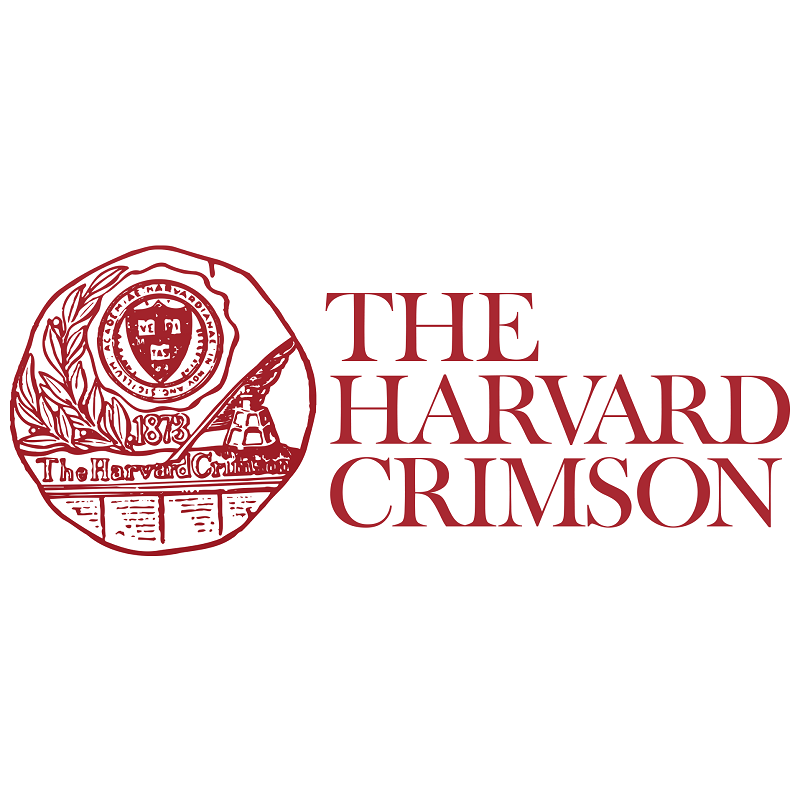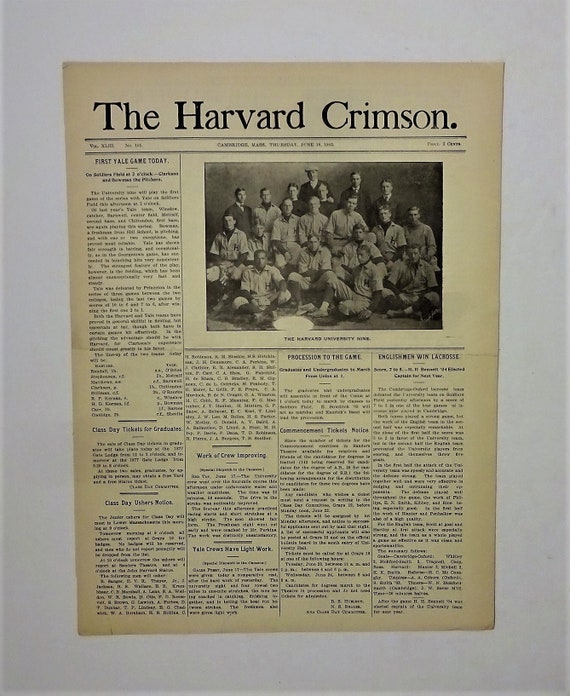Unveiling The Legacy Of The Harvard Crimson Newspaper: A Pillar Of Campus Journalism
When you think about iconic campus newspapers, the Harvard Crimson stands tall as a beacon of journalistic excellence. Founded in 1873, this legendary publication has been shaping the world of student journalism for over a century. As one of the oldest and most respected college newspapers in the United States, the Crimson has earned its reputation through relentless dedication to uncovering truth, sparking meaningful conversations, and giving voice to the Harvard community. But what exactly makes this newspaper so special? Let’s dive in and uncover its incredible legacy.
This isn’t just another campus paper. The Harvard Crimson has produced some of the brightest minds in journalism, politics, and academia. It’s more than a publication; it’s a training ground for future leaders who want to make an impact on the world. From its humble beginnings to its current status as a digital powerhouse, the Crimson continues to evolve while staying true to its core values.
As we explore its storied history, you’ll discover how the Crimson has adapted to changing times, faced challenges, and remained a pillar of campus journalism. So, whether you’re a Harvard alum, a journalism enthusiast, or simply curious about the power of student media, this article will give you a deep dive into the heart of what makes the Harvard Crimson so remarkable.
Read also:Chen Zheyuan Family A Comprehensive Look Into The Life And Legacy Of A Rising Star
Table of Contents
- A Journey Through Time: The History of the Harvard Crimson
- Biography: Meet the Harvard Crimson
- Core Values: What Makes the Crimson Stand Out
- The Crimson's Impact on Campus Culture
- Overcoming Challenges in Modern Journalism
- Embracing the Digital Age: The Crimson’s Online Presence
- Notable Alumni: Where Are They Now?
- The Future of the Harvard Crimson
- Ethics in Journalism: How the Crimson Leads the Way
- Conclusion: Why the Harvard Crimson Matters
A Journey Through Time: The History of the Harvard Crimson
Let’s rewind the clock back to 1873, when a group of Harvard students decided it was time to give voice to their peers. The Harvard Crimson started as a modest publication, but its ambitions were anything but small. Back then, the newspaper was printed weekly, and its pages were filled with news, opinions, and sports updates. Over the years, the Crimson grew in both size and influence, becoming a daily publication by 1900.
Fast forward to today, and the Crimson is a thriving multimedia platform. But don’t let its modern tech-savvy approach fool you. At its core, the Crimson remains committed to the same principles that guided its founders: truth, transparency, and accountability. Whether it’s covering breaking news on campus or tackling controversial topics, the Crimson has always been at the forefront of student journalism.
Key Milestones in the Crimson's History
- 1873: The Harvard Crimson is founded by a group of students.
- 1900: The newspaper transitions from a weekly to a daily publication.
- 1977: The Crimson becomes the first college newspaper to publish a daily editorial page.
- 2010: The Crimson launches its digital edition, expanding its reach beyond Harvard’s campus.
Biography: Meet the Harvard Crimson
Now that we’ve covered the basics, let’s get to know the Harvard Crimson a little better. Think of it as a living, breathing entity that’s constantly evolving. The Crimson operates as a student-run organization, meaning that every article, photo, and design is crafted by Harvard students. This hands-on experience is invaluable for aspiring journalists, as it allows them to learn the ropes in a real-world setting.
Here’s a quick overview of the Crimson’s key stats:
Harvard Crimson Facts
| Year Founded | 1873 |
|---|---|
| Publication Frequency | Daily |
| Staff Size | Approximately 200 students |
| Editorial Focus | News, Opinions, Arts, Sports, and More |
Core Values: What Makes the Crimson Stand Out
So, what exactly sets the Harvard Crimson apart from other campus newspapers? It’s not just about the content—it’s about the values that drive the publication. The Crimson is committed to upholding the highest standards of journalism. This means fact-checking every article, maintaining a balanced perspective, and holding those in power accountable.
One of the things that makes the Crimson unique is its dedication to giving voice to underrepresented communities on campus. Whether it’s covering issues related to diversity, inclusion, or social justice, the Crimson strives to amplify voices that might otherwise go unheard. And let’s not forget about the editorial page, where students can express their opinions freely and engage in meaningful debates.
Read also:Barron Trump The Antichrist Theory Explored
Key Values of the Harvard Crimson
- Integrity: Always tell the truth, even when it’s uncomfortable.
- Inclusivity: Highlight diverse perspectives and voices.
- Innovation: Embrace new technologies and storytelling methods.
The Crimson's Impact on Campus Culture
As the largest and most influential student organization at Harvard, the Crimson plays a crucial role in shaping campus culture. Its articles often spark heated discussions, challenge long-held beliefs, and inspire change. Whether it’s exposing a scandal, advocating for policy reform, or simply keeping students informed, the Crimson is always at the center of the action.
But the Crimson’s influence extends beyond Harvard’s campus. Its alumni have gone on to shape the world of journalism, politics, and beyond. Many of today’s top journalists, authors, and thought leaders got their start at the Crimson. It’s like a breeding ground for greatness, and its impact can be felt far and wide.
How the Crimson Shapes Campus Conversations
- Covering controversial topics that others might shy away from.
- Providing a platform for students to express their views.
- Engaging with the broader community through partnerships and events.
Overcoming Challenges in Modern Journalism
Like any other publication, the Harvard Crimson has faced its fair share of challenges over the years. The rise of social media, declining ad revenues, and changing reader habits have all posed significant threats to traditional journalism. But the Crimson hasn’t shied away from these challenges. Instead, it’s embraced them head-on, adapting to the times while staying true to its mission.
One of the biggest challenges the Crimson has faced is maintaining its independence. As a student-run publication, it operates outside the university’s administrative structure. This means that the Crimson has the freedom to criticize Harvard’s policies and practices without fear of retribution. But it also means that the publication must rely on its own resources to survive.
Strategies for Success
- Investing in digital content and multimedia storytelling.
- Building a strong community of supporters through crowdfunding and donations.
- Partnering with other student organizations to amplify its reach.
Embracing the Digital Age: The Crimson’s Online Presence
In today’s digital age, having a strong online presence is essential for any publication. The Harvard Crimson has embraced this reality, launching a robust website and social media platforms that keep readers engaged and informed. Its digital edition features everything from breaking news to in-depth investigations, all delivered straight to your device.
But the Crimson doesn’t just stop at text-based content. It also produces videos, podcasts, and interactive graphics that bring stories to life in new and exciting ways. This multimedia approach ensures that the Crimson remains relevant to a younger generation of readers who consume news differently than their predecessors.
Key Features of the Crimson’s Digital Edition
- Breaking news alerts sent directly to your inbox.
- Engaging multimedia content that complements written articles.
- Interactive features that allow readers to explore data and statistics.
Notable Alumni: Where Are They Now?
One of the most fascinating aspects of the Harvard Crimson is its impressive alumni network. Over the years, the publication has produced some of the most influential figures in journalism, politics, and academia. These individuals have gone on to shape the world in countless ways, and their success is a testament to the Crimson’s impact.
Some notable alumni include Pulitzer Prize-winning journalists, best-selling authors, and even a former U.S. President. While their paths may have diverged, one thing remains constant: the lessons they learned at the Crimson continue to guide them in their careers.
Spotlight on Alumni
- David Remnick: Editor of The New Yorker and Pulitzer Prize-winning author.
- George Stephanopoulos: Journalist and television personality.
- Barack Obama: 44th President of the United States.
The Future of the Harvard Crimson
As we look to the future, the Harvard Crimson is poised to continue its legacy of excellence. With new technologies emerging and changing reader habits, the publication is well-positioned to adapt and thrive in the years to come. Its commitment to innovation, inclusivity, and integrity will ensure that it remains a pillar of campus journalism for generations to come.
But the Crimson’s future isn’t just about survival—it’s about growth. By expanding its reach, embracing new storytelling methods, and continuing to champion underrepresented voices, the Crimson will continue to be a force for good in the world of journalism.
What’s Next for the Crimson?
- Expanding its digital offerings with more multimedia content.
- Engaging with a global audience through partnerships and collaborations.
- Continuing to push the boundaries of student journalism.
Ethics in Journalism: How the Crimson Leads the Way
Journalism is more than just reporting the news—it’s about upholding ethical standards and holding those in power accountable. The Harvard Crimson has always been a leader in this regard, setting an example for other student publications to follow. Its commitment to truth, transparency, and accountability is what makes it such a respected institution in the world of journalism.
But ethics in journalism isn’t just about following rules—it’s about making tough decisions and standing by your principles, even when it’s difficult. The Crimson has faced its share of controversies over the years, but it has always risen to the occasion, proving that integrity is at the heart of everything it does.
Key Ethical Principles
- Fact-checking every article before publication.
- Maintaining a balanced perspective in reporting.
- Protecting sources and respecting privacy.
Conclusion: Why the Harvard Crimson Matters
In a world where journalism is under attack, the Harvard Crimson stands as a shining example of what journalism can and should be. Its commitment to truth, transparency, and accountability has earned it a place in the pantheon of great publications. But more than that, the Crimson is a testament to the power of student journalism to shape the world.
So, whether you’re a Harvard student, a journalism enthusiast, or simply someone who cares about the future of media, the Harvard Crimson is worth your attention. It’s not just a newspaper—it’s a movement, a community, and a legacy that continues to inspire. So, take a moment to explore its pages, engage with its content, and support its mission. Because in the end, the Harvard Crimson matters, and its legacy will continue to unfold for years to come.
What do you think about the Harvard Crimson’s impact on campus journalism? Leave a comment below and let’s continue the conversation. And don’t forget to share this article with your friends and followers. Together, we can celebrate the power of student journalism and the incredible legacy of the Harvard Crimson!
Article Recommendations


